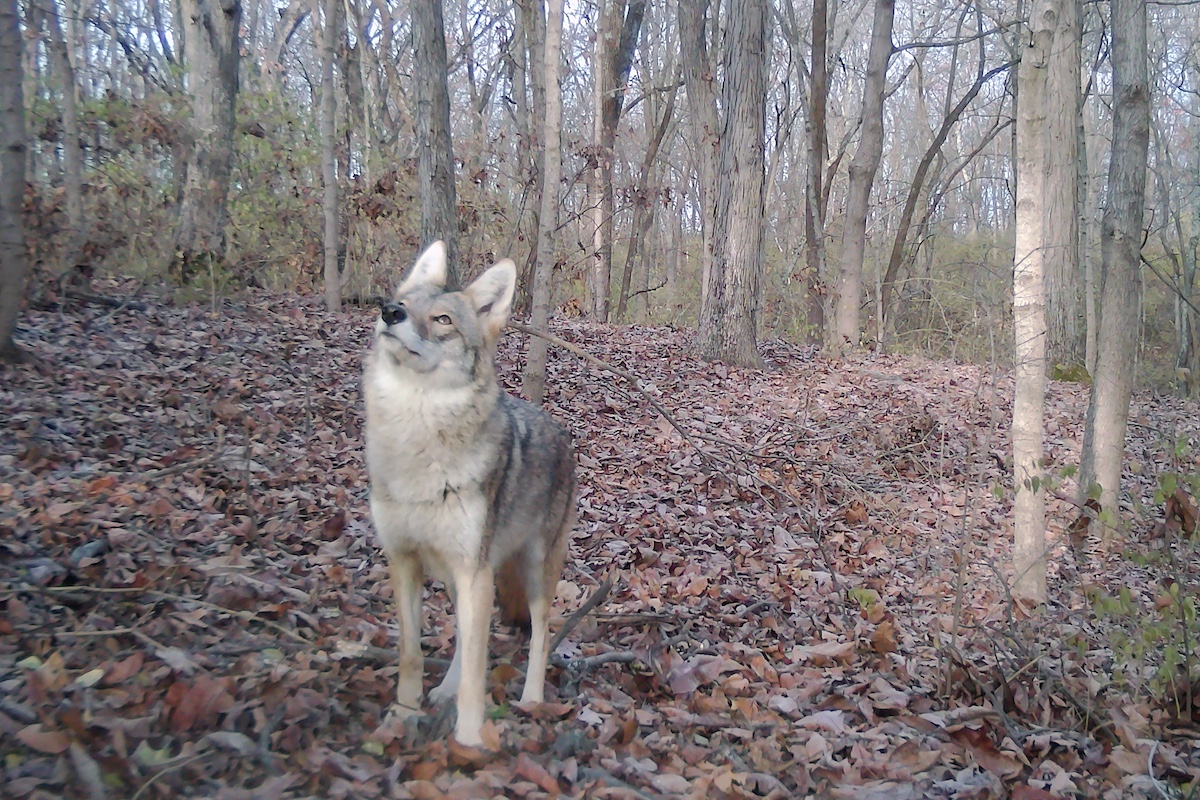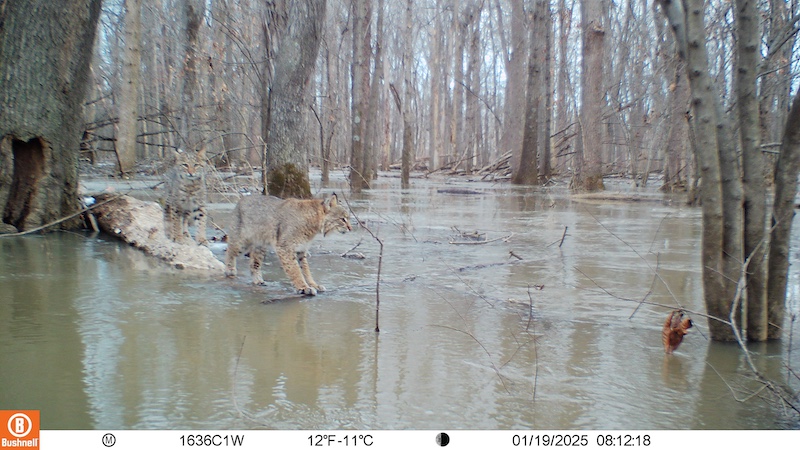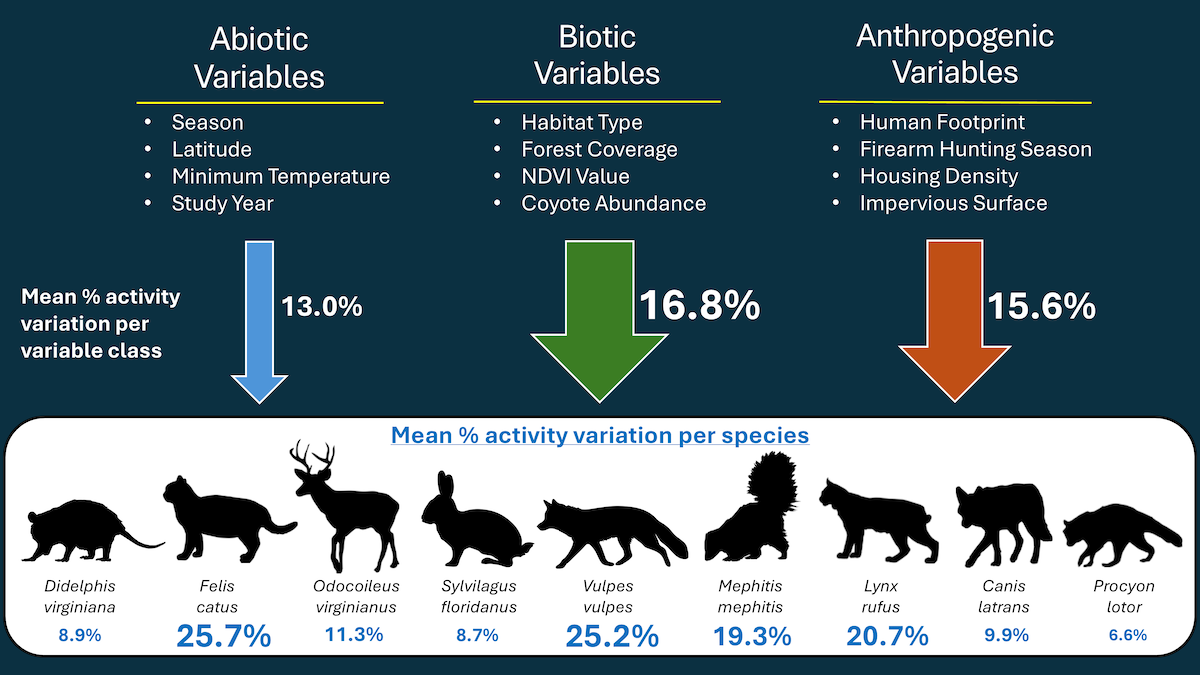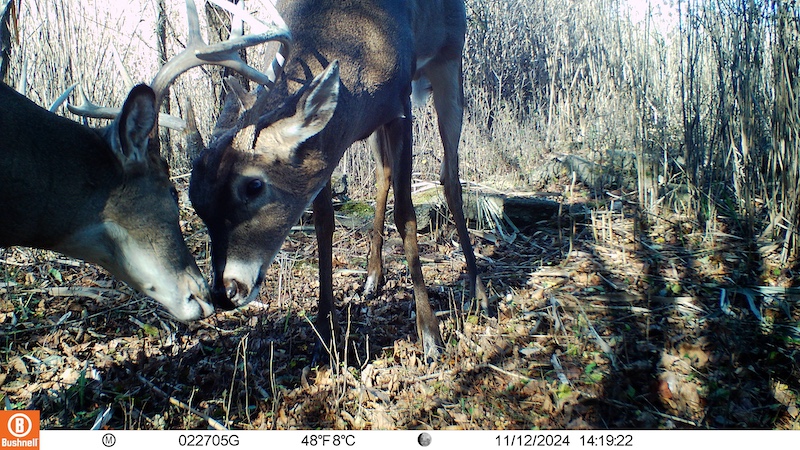
Coyote caught on camera trap watching birds. Photo by Nathan J. Proudman and Maximilian L. Allen.




Coyote caught on camera trap watching birds. Photo by Nathan J. Proudman and Maximilian L. Allen.
The daily movements of the sun are one of the most important natural cycles shaping the behaviors of animals in the natural world. Animal activity patterns can be broadly classified into four groups: nocturnal (active during the night), diurnal (active during the day), crepuscular (active at twilight) and cathemeral (can be active during all periods). At what times of day animals choose to be active can influence both the survival and fitness of wildlife, with ripple effects for the broader food web. For instance, predators often synchronize their activities to match the activity patterns of their preferred prey to increase foraging efficiency, while prey species may seek to avoid being active during times of the day when they are most vulnerable to predators. Furthermore, competition for resources could see some species becoming active during suboptimal times of the day because it frees them from more intense competition or aggressive encounters with other dominant competitors. In this way, the activity patterns of wildlife are highly interconnected, and often influenced by the local community of species present. While some species have strict activity schedules, other species are more flexible and can adjust their activity to best suit their environment. So, what are some factors that affect when animals are active?

For many species, temperature can be the most important factor shaping activity patterns. In wintery conditions, reducing activity and retreating to dens or nests during the coldest part of the night can help reduce energy expenditure as the body attempts to thermoregulate. Meanwhile, in hot, desert conditions, avoiding the hottest part of the day can reduce water loss and exhaustion. Habitat type may also dictate when an animal is active. For example, some habitats may harbor more nocturnal prey for predators, while other habitats may contain more diurnal prey. For prey species, some habitats may provide vegetation cover for concealment against predators, while others may be more open, so may be avoided during high-risk times of day.
Lastly, humans can have a large effect on the activity patterns of wildlife. As humans continue to encroach upon natural spaces, many wild species have shifted their activities to become more nocturnal as a means of reducing potential encounters with humans. This phenomenon is well documented across the globe and is arguably most evident in mammal species. In addition to the direct effects that humans pose through fear of encounters, humans can also affect animal activity in more indirect ways, such as through artificial lighting and the secondary effects of human-induced climate change – affecting mammals’ thermoregulatory processes.

With all these factors known to affect the activity patterns of wild mammals, what drives these patterns among mammals in the highly modified, agricultural landscapes of Illinois? Although many studies have examined how humans or other factors dictate the times of day in which animals are active, few have considered a broad range of factors for multiple species inhabiting the same ecosystem. Therefore, my coauthor and I wished to investigate this phenomenon using our statewide camera trap network. In a study recently published in Integrative Zoology and funded by the Illinois Department of Natural Resources (Federal Aid in Wildlife Restoration Program W-211-R), we tapped into our camera trap data collected over the course of two winters, 2021-22 and 2022-23. We partitioned our photo data into discrete groups by splitting up camera sites based on low and high values of predictor variables relative to the state of Illinois. We then compared the activity patterns of nine mammal species between these site groupings. The predictor variables we used represented abiotic (non-biological factors, such as weather conditions and latitude), biotic (habitat characteristics and the presence of the apex predator – coyotes), and human-related factors (e.g. housing densities, hunting season). The focal mammal species represented a range of ecologies and behaviors, including predators such as coyotes and bobcats, prey like white-tailed deer and eastern cottontails, and omnivorous generalists such as raccoons and skunks.
We found that the various mammal species differed considerably in their behavioral flexibility, with some species exhibiting substantially different activity patterns between environments, while others maintained the same activity patterns regardless of where they were located. Domestic cats, red foxes, bobcats and skunks were the most flexible species, while raccoons and coyotes maintained consistent, primarily nocturnal schedules.
Overall, biotic factors (the living components of an ecosystem) were responsible for the greatest activity shifts, with several species becoming more nocturnal in open habitat. For example, white-tailed deer were observed less often during the day in grassland habitat compared to forest habitat. Also, domestic cats seemed to avoid the nocturnal period where coyotes were most abundant, most likely to avoid predation.
Several species also varied in their activity schedules based on human-related factors. For example, domestic cats were more nocturnal in areas with greater housing densities and human footprints, most likely a result of unowned or feral cats avoiding humans during the day.
Abiotic variables (the non-living chemical and physical parts of an environment that affect living organisms and ecosystems), meanwhile, had little effect on activity patterns, only substantially affecting the species most sensitive to winter temperatures – the marsupial, Virginia opossum.


With many mammal species exhibiting considerable variation in their daily activity patterns, our study demonstrates the importance of environmental conditions (particularly habitat structure, coyotes, and humans) on the natural biological rhythms of wildlife. For biologists, understanding what factors may influence activity patterns will improve sampling efficiency when monitoring wildlife to inform management and conservation actions. Furthermore, when and where animals choose to be active can have rippling effects on other species within an ecosystem, due to the interconnected properties of food webs. Direct and indirect human activities can disrupt the natural synchronies of wildlife, and it is important we understand the ramifications of this if we are to preserve healthy, functioning ecosystems.
Nathan Proudman jest adiunktem podoktorskim (Postdoctoral Research Associate) w Illinois Natural History Survey. Jego badania koncentrują się głównie na ekologii ssaków. Obecnie pracuje nad ogólnostanowym programem monitoringu ssaków w stanie Illinois.
Prześlij pytanie do autora